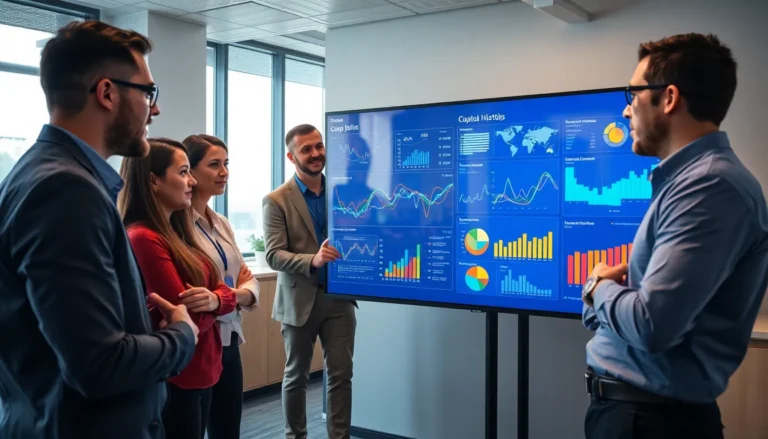In a world where change is the only constant, foresight analysis stands as the crystal ball of strategic planning. Imagine being able to predict trends and navigate uncertainties like a seasoned captain steering through stormy seas. This isn’t just a fancy term tossed around in boardrooms; it’s a powerful tool that can transform how businesses anticipate the future.
Foresight analysis helps organizations identify potential challenges and opportunities before they even knock on the door. It’s like having a cheat sheet for the future, allowing decision-makers to make informed choices that keep them ahead of the curve. So, if you’re tired of reacting to trends instead of setting them, it’s time to dive into the fascinating world of foresight analysis and discover how it can turn you into a visionary leader. Who said planning for tomorrow couldn’t be fun?
Table of Contents
ToggleOverview of Foresight Analysis
Foresight analysis plays a crucial role in strategic planning. It equips organizations to predict trends and effectively manage uncertainties.
Definition and Importance
Foresight analysis involves systematic exploration of future possibilities. It emphasizes understanding emerging trends and their implications. Organizations utilize this tool to minimize risks and identify opportunities. Decision-makers gain insights to make proactive choices. This analysis fosters a culture of innovation and adaptability. Leaders who embrace foresight analysis position their organizations to thrive in changing environments.
Key Components
Foresight analysis comprises several key components. Scanning the environment remains essential for identifying relevant trends. Involving stakeholder engagement enhances insights and perspectives. Scenario planning allows leaders to visualize potential futures. Monitoring signals aids in recognizing early indicators of change. Lastly, integrating quantitative and qualitative data ensures a comprehensive understanding of possibilities. Each component strengthens the overall foresight analysis process, promoting informed decision-making.
Methodologies in Foresight Analysis

Foresight analysis employs various methodologies, combining both qualitative and quantitative approaches for comprehensive insights into future trends.
Qualitative Methods
Qualitative methods focus on understanding underlying trends, perceptions, and motivations. Techniques like interviews and focus groups gather deep insights from stakeholders, fostering a rich dialogue about potential futures. Delphi studies involve repeated rounds of questioning among experts to build consensus on future developments. Additionally, scenario workshops engage participants in collaborative discussions, enabling them to visualize different pathways. These methods prioritize subjective insights, which complement quantitative findings, enhancing the overall foresight analysis process.
Quantitative Methods
Quantitative methods rely on numerical data to reveal patterns and trends. Statistical analysis plays a significant role, allowing organizations to evaluate historical data and forecast future scenarios. Surveys collect responses from a larger audience, providing valuable metrics for analysis. Data mining techniques uncover hidden trends within vast datasets, helping organizations identify emerging signals. Simulation models enable testing various scenarios, providing insights into potential outcomes based on specific variables. By integrating these methods, organizations can establish a well-rounded understanding of future possibilities, reducing uncertainty in decision-making.
Applications of Foresight Analysis
Foresight analysis plays a critical role in various business applications, influencing strategic decisions and fostering innovation.
Strategic Planning
Foresight analysis enhances strategic planning by enabling organizations to anticipate shifts in their industries. By systematically identifying emerging trends and disruptions, companies can craft informed strategies that align with future potentials. Executives utilize scenario planning to visualize multiple outcomes, ensuring their plans remain relevant despite uncertainties. Environmental scanning keeps leaders informed about evolving market dynamics, guiding them in resource allocation and investment decisions. Engaging stakeholders throughout this process provides diverse perspectives, enriching analytical insights. Ultimately, this proactive approach cultivates resilience, ensuring firms effectively navigate competitive landscapes.
Innovation Management
Foresight analysis significantly contributes to innovation management by identifying opportunities for new products and services. Companies leverage insights gained from environmental scanning to align research and development efforts with market needs. Engaging with customers and stakeholders helps uncover unmet demands, driving creative ideation. Scenario planning allows organizations to explore various pathways for innovation, minimizing risks associated with new ventures. Additionally, integrating foresight methodologies fosters a culture that embraces change, encouraging teams to think outside established paradigms. As a result, organizations equipped with foresight analysis are better positioned to pioneer breakthroughs and maintain an edge in their sectors.
Challenges in Foresight Analysis
Foresight analysis faces several challenges that can limit its effectiveness. Addressing these obstacles is essential for organizations aiming to enhance their strategic insights.
Data Limitations
Data quality and availability often present major challenges in foresight analysis. Incomplete datasets can skew forecasts and misrepresent trends. Many organizations struggle to access real-time information, which is crucial for timely decision-making. Furthermore, reliance on outdated or biased data can lead to incorrect assumptions about future scenarios. Fostering strong data collection methods and investing in innovative technologies can mitigate some of these issues.
Stakeholder Engagement
Engaging stakeholders effectively is vital for successful foresight analysis. Diverse perspectives contribute to a richer understanding of potential futures. Many organizations encounter difficulties in aligning stakeholder views, which may lead to conflicting opinions on priorities. Achieving buy-in from key individuals reinforces the analysis process and enhances its credibility. To overcome these obstacles, organizations should create structured platforms for ongoing dialogue, ensuring that all voices are heard and considered in the foresight analysis.
Future Trends in Foresight Analysis
Future trends in foresight analysis revolve around emerging technologies and global perspectives that shape strategic insights.
Technological Advancements
Artificial intelligence reshapes foresight analysis by automating data processing and enhancing predictive accuracy. Tools utilizing machine learning improve scenario planning, allowing organizations to analyze vast datasets effectively. Real-time data analytics enables quicker responses to shifts in market dynamics. Virtual reality and simulation provide immersive environments for testing various future scenarios, which brings deeper insights into potential outcomes. Blockchain technology ensures data integrity and fosters transparency in stakeholder engagement processes. These technological innovations create significant opportunities for organizations to strengthen foresight analysis and refine decision-making.
Global Perspectives
Diverse global perspectives enhance foresight analysis by incorporating varying cultural insights and trends. Cross-border collaboration fosters richer discussions around emerging challenges and opportunities. Businesses tapping into international forecasts can identify macroeconomic factors that influence domestic markets. Expanding the network to include stakeholders from various regions encourages more comprehensive environmental scanning. Regional variations in consumer behavior and expectations inform tailored strategies that resonate with local markets. Integrating these global viewpoints empowers organizations to adapt proactively to changing landscapes and succeed in a competitive world.
Foresight analysis stands as a critical tool for organizations aiming to thrive in an ever-changing landscape. By systematically exploring future possibilities, businesses can not only identify opportunities but also mitigate risks. The integration of qualitative and quantitative methodologies enhances the depth of insights gained, ensuring informed decision-making.
As organizations embrace foresight analysis, they position themselves as proactive leaders rather than reactive followers. The ability to anticipate industry shifts and adapt accordingly fosters resilience and innovation. By investing in robust data collection and engaging diverse stakeholder perspectives, firms can refine their foresight practices, ultimately paving the way for sustained success in a competitive environment.









